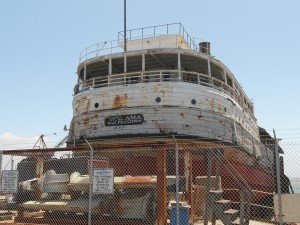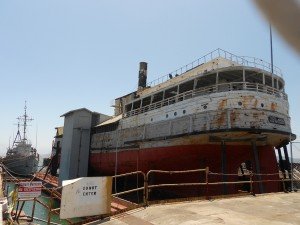
The history of shipping along the California coast is a colorful subject. At this writing there is a old and historic steamer schooner in dry dock at Point Richmond California, across the bay from San Francisco. The steam schooner Wapama (sometimes referred to as the “Tongass”) is a National Historic Landmark and brings us back to the day when the west coast lumber industry was booming. Timber products were in great demand and the northwest Pacific coast has plenty of trees. Oregon lumber was in great demand and the west coast of America offered a lot of opportunities for steamship concerns. There were a total of about 225 steam schooners built especially for the lumber trade and the Wapama has the distinction of being the last one still surviving.
Thank you for reading this post, don't forget to subscribe!The Wapama is a wooden hull vessel made from Douglas fir . The Douglas fir tree was popular with shipbuilders of the era. The ship was built in 1915 and was in service until 1947. During the early 1900’s, both shipping and railroad companies transported quite a lot of lumber in northern California and Oregon. The vessel Wapama was originally built for the steamship company of Charles R. McCormick, a former lumberman. The McCormick Steamship Company was in business between 1903 and 1040. McCormick initially had several investors with an interest in a fleet of vessels. In 1921, he acquired everyone’s interests and issued stock. McCormick managed the company successfully and with his profits was able to enlarge his fleet of steamers. The Wapama plied the ocean regularly between California and Oregon. The vessel has a length of 216 feet and a beam of 40 feet. It’s gross tonnage is 951. The Wapama is best noted for it’s high superstructure on the stern and a high forecastle on the bow. The Wapama had one main hatch for loading. The ship could carry an enormous amount of board feet lumber in addition to about 60 passengers. This steam vessel was powered by water tube boilers burning diesel fuel. The engine was triple expansion with 800 horse power.

The Wapama was sold to the National Park Service in 1977. This was for inclusion in it’s Golden Gate National Recreation Area. In the history of ships, the Wapama was a unique artifact. The old ship had been on display in San Francisco at it’s Maritime Museum at Fishermans Wharf. In 1979, due to it’s deteriorating hull condition, the Wapama was put on a barge to avoid it’s possible sinking. Today, as mentioned above, the Wapama sits in dry dock at Point Richmond and is not open to visitors. The photos on this page show just how far the wood hull has deteriorated over the years. You can get good views of the steamer on the road passing it’s dry dock.
While the vessel is quite old and in obvious need of restoration, viewing it yourself is an impressive experience. In 2011, the National Park Service announced that the Wapama would be dismantled but as of this date it has not been. What eventually happens to this historic steamer is still officially undecided. The cost of restoration would be quite costly. There has been a lot of concern voiced by people in favor of preservation but the economics will probably prevent that from occurring. The idea of perhaps saving it’s engine has also been suggested.
The Wapama certainly is a big piece of west coast history and it would be a good thing if somehow the vessel could be saved and made into an historical exhibit. If that is not possible, something from the ship, such as the engine, needs to be preserved for future generations. I think that destroying what is the last of a fleet of over 200 unique vessels would not serve very well. The ship has been condemned but historians have continued to make arguments against the NPS directive. If you feel strongly about this yourself I would suggest you contact the NPS by phone or email to express your support for saving the Wapama.
Two additional articles we’ve published which you’ll find interesting are the GP Griffith Lake Erie Disaster and the Mosquito Fleet of Puget Sound.
(Photos are from author’s private collection)
